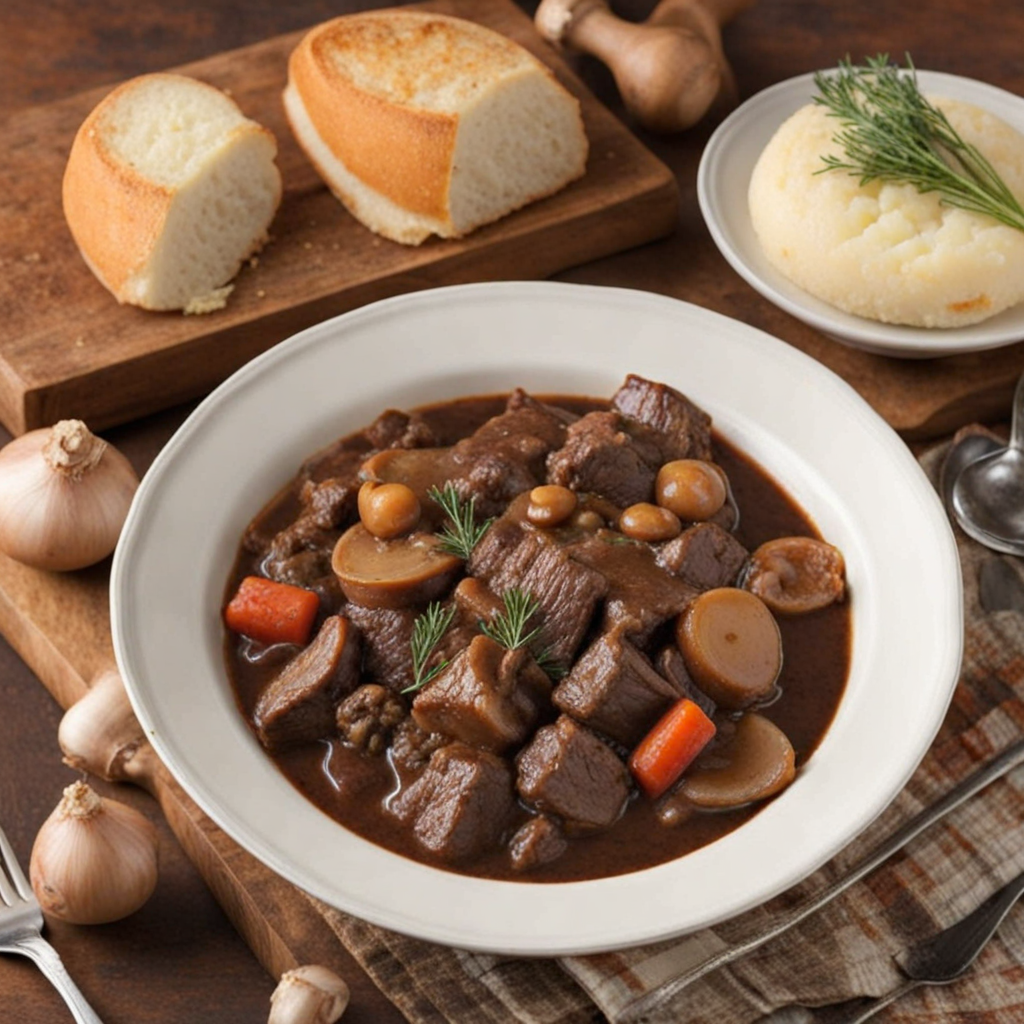Salade Niçoise
Salade Niçoise is a vibrant and refreshing dish that hails from the sunny region of Nice, France, embodying the essence of Mediterranean cuisine. This classic salad typically features a base of crisp, fresh greens, such as romaine or butter lettuce, which provide a delightful crunch. The dish is adorned with an array of colorful ingredients, including ripe cherry tomatoes, thinly sliced red onions, and green beans, which contribute both texture and visual appeal. A key element of the salad is the inclusion of high-quality olives, often Niçoise olives, which impart a briny, rich flavor that complements the other components beautifully. Adding to its charm, Salade Niçoise often incorporates hard-boiled eggs, which lend a creamy and satisfying element to the dish. The protein factor is elevated further with the inclusion of tuna; traditionally, this is fresh seared or canned tuna, providing a hearty, savory element that balances the lighter ingredients. The salad is typically dressed with a simple mixture of olive oil, vinegar, and Dijon mustard, enhancing the flavors without overpowering the fresh produce. Salade Niçoise is not just a salad; it's a celebration of the region's bounty and a perfect representation of the French culinary ethos that values fresh, seasonal ingredients. This dish can be enjoyed on its own as a light meal or as a side to complement grilled meats or crusty bread. Each bite offers a symphony of flavors, from the sweetness of tomatoes to the saltiness of olives, making it a delightful experience for anyone eager to explore the tastes of France.
How It Became This Dish
The History of Salade Niçoise: A Culinary Journey through Time Salade Niçoise is more than just a salad; it is a vibrant culinary emblem of the French Riviera, specifically the city of Nice. This dish encapsulates the essence of Mediterranean cuisine, combining fresh ingredients with a philosophy of simplicity and harmony. Its origins, cultural significance, and evolution reflect the rich tapestry of history and tradition in the region, making it a beloved dish not only in France but around the world. #### Origins: A Taste of the South The roots of Salade Niçoise can be traced back to the early 19th century in Nice, where local farmers and fishermen would create simple salads using the abundant produce of the region. The Mediterranean climate allows for a rich variety of vegetables, and the proximity to the sea means that fresh fish was readily available. Traditional recipes often included ingredients such as tomatoes, olives, anchovies, and hard-boiled eggs, united by a drizzle of high-quality olive oil—a staple of Mediterranean diets. The first known written recipe for Salade Niçoise appeared in the famous cookbook "La Cuisine de Nice" by the culinary writer and chef, Louis Pisani, in the late 19th century. Pisani’s recipe emphasized the use of fresh, local ingredients, which would become the hallmark of the dish. Unlike the more elaborate French salads that were common during this time, Salade Niçoise celebrated simplicity and the flavors of the ingredients themselves. #### Cultural Significance: A Reflection of Regional Identity Salade Niçoise is deeply intertwined with the cultural identity of Nice and the surrounding Provence region. As a coastal city, Nice has historically been a melting pot of cultures, influenced by Italian, Greek, and Arab culinary traditions, owing to its strategic location along trade routes. The salad reflects this cultural synthesis, combining elements from various traditions while maintaining a distinctly Niçoise character. The use of fresh, seasonal produce in Salade Niçoise speaks to the Mediterranean lifestyle, which values health, sustainability, and a connection to the land. The salad is typically served as a main course, especially during the summer months when the ingredients are at their peak. It’s a dish meant to be shared, often enjoyed al fresco with family and friends, embodying the convivial spirit of the region. In addition to its local significance, Salade Niçoise has gained international acclaim. It became a symbol of the French culinary renaissance in the 20th century, when chefs began to focus on regional dishes and emphasized the importance of local ingredients. The salad’s appeal lies not only in its flavors but also in its representation of the Mediterranean lifestyle—a celebration of fresh food, communal dining, and a slower pace of life. #### Development Over Time: From Tradition to Modernity As culinary trends evolved, so too did the Salade Niçoise. The original recipes varied significantly from household to household, with each family adding their own twist to the dish. However, certain ingredients remained constants: ripe tomatoes, crisp green beans, briny black olives (preferably Niçoise olives), and anchovies. Hard-boiled eggs were also a common feature, providing richness to the salad. In the mid-20th century, the salad began to gain popularity beyond the confines of Nice. As French cuisine became more celebrated globally, Salade Niçoise made its way to restaurants and homes around the world. However, with this globalization came variations and adaptations. One of the most notable deviations is the inclusion of tuna, which, while not traditional, has become widely accepted in many modern interpretations. Canned tuna, particularly in olive oil, is often used for convenience, and while purists might argue it strays from the authentic preparation, it has undeniably contributed to the salad’s popularity outside France. In contemporary cuisine, Salade Niçoise has been reimagined in numerous ways. Chefs have begun experimenting with the presentation and composition, incorporating ingredients like quinoa, avocado, or even grilled vegetables. Some modern variations veer away from the traditional balance of ingredients, leading to debates about what constitutes an authentic Salade Niçoise. Despite these changes, the essence of the dish remains intact. At its core, Salade Niçoise is about celebrating fresh, high-quality ingredients. It is a dish that invites creativity while honoring its roots, allowing for personal expression within a framework of tradition. #### Conclusion: A Timeless Classic Salade Niçoise stands as a testament to the rich culinary heritage of Nice and the broader Mediterranean region. Its journey from humble beginnings to a celebrated international dish mirrors the complexities of cultural exchange and adaptation. While it has evolved over time, the salad continues to evoke the sun-drenched landscapes of the French Riviera, vibrant markets filled with fresh produce, and the joy of communal meals shared among family and friends. In a world where fast food and convenience often take precedence, Salade Niçoise serves as a reminder of the importance of quality ingredients and the pleasures of seasonal cooking. As we enjoy this delightful salad, we partake in a tradition that spans generations, savoring not just the flavors but also the history and culture that it represents. Whether served in a rustic bistro in Nice or a modern café in Tokyo, Salade Niçoise remains a beloved dish, inviting us to pause, appreciate, and enjoy the simple pleasures of life.
You may like
Discover local flavors from France







